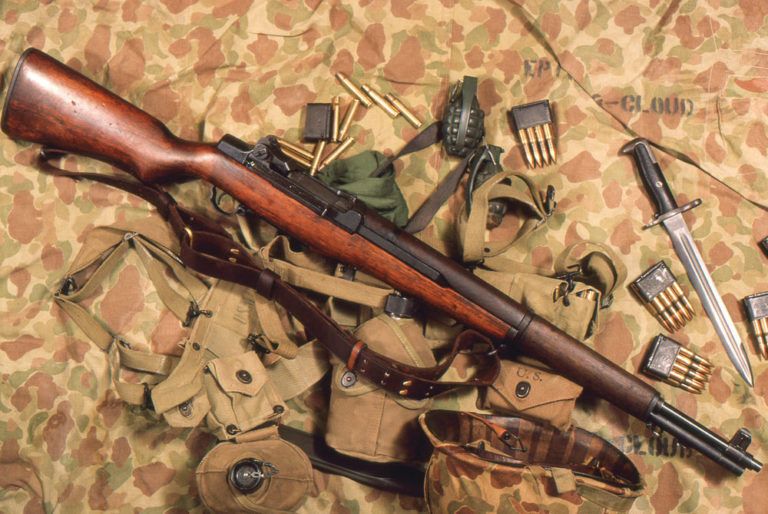
The Fourth of July is, of course, a time for we Americans to celebrate our liberties and inalienable rights. Here at Gun Digest, one right is always floating around our heads, particularly on our Nation's birthday — the right to bear arms. Not only does the Second Amendment give us the ability to thwart tyranny and protect ourselves and our families, it also has spawned incredible firearms along the way.
We Americans have a knack at engineering, especially when it comes to guns. We cut some out of whole cloth and others we improve on time-tested designs. And in the end, we come up with implements that change world history.
With that in mind, here are the top 10 most American guns of all time. Of course, we know we might've left out your favorite or added one you don't agree with. Share your thoughts in the comments below.
What Are The Top American Guns:
- American Long Rifle
- Colt Paterson
- 1860 Henry Rifle
- Model 1873 Colt Single Action Army
- Springfield 1903
- 1911 Pistol
- Browning M2
- M1 Garand
- AR-15
- Remington Model 870
- M1 Carbine
American Long Rifle

Good for injecting lead into distant deer and Red Coats alike. More generally known now as the Kentucky or Pennsylvania rifle, these elegant flintlocks are a symbol of American independence. And they gave the Colonists a great advantage in the American Revolution, with the gun's rifled bore and long barrels extending their user's effective range out to 200 yards and beyond. While they played a role in the American War for Independence, it was small compared to the British-made Brown Bess Musket, the primary arm of our Nation’s Army. The rifles came about during the French and Indian War with Lancaster, Pa., the most commonly referenced place of origin. It is generally accepted that the American Long Rifle was a modification of the Germanic Jäger rifle, produced by Swiss and Germen settlers of the region. But there are more recent theories that suggest English Trade Guns also had a large influence on the design, particularly the American Long Rifle’s longer barrel and smaller caliber.
Colt Paterson

To be sure, old Sam Colt and his company would go on to produce much more iconic firearms. But the wellspring was the Paterson. Patented in 1836 and produce until 1842, the cap-and-ball, black-powder pistol was the first commercially successful repeating firearm to use a revolving cylinder. As Colt’s fans most likely know, the popular story is Colt conceived of the revolver during his teenage years at sea, inspired by the ship's steering mechanism. That might be, but there were likely examples of flintlock revolvers — such as Elisha Collier’s — he saw on his trip. They were somewhat common in India, and his destination was Calcutta. No matter how inspiration struck, we Americans are sure happy it did. Not only did the design lead to some true firearms legends, it’s still a concept that dominates nearly 200 years later. Photo: Hmaag
Learn More About The Colt Patterson
1860 Henry Rifle
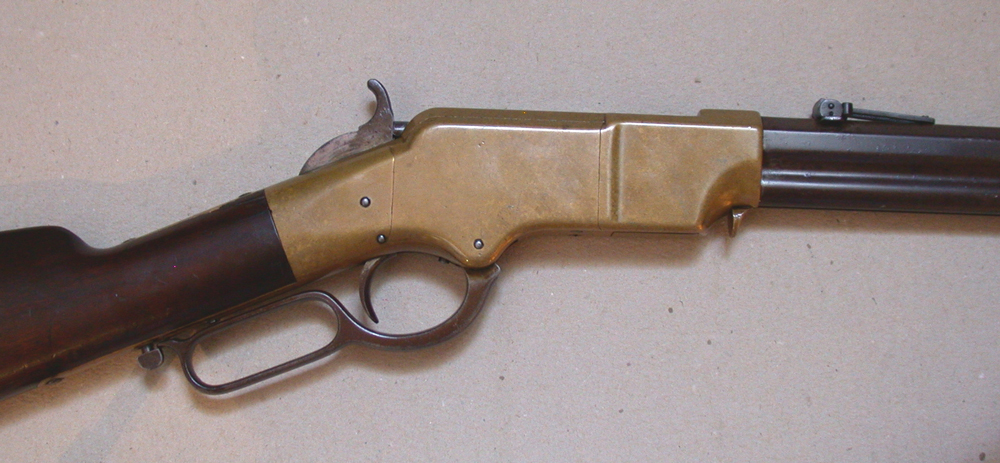
If the brass receiver of the 1860 Henry doesn’t spark some primal urge to thumb off 16 rounds as fast as you can work the lever, then there is no hope for you. The repeating rifle was the brainchild of Benjamin Tyler Henry, sort of. It was basically an improvement on Volition and Volcanic rifles, designs Oliver Winchester acquired when Volcanic Repeating Arms went bankrupt. Henry soon set to refining the design when he was hired by Winchester in 1858 as superintendent at the New Haven Repeating Arms Company. Perhaps one of the weightiest modifications was the self-cocking mechanism that operated in concert with the lever-action. The gun saw some action in the Civil War, but was by no means the dominant arm of the conflict. However, the fact soldiers would spend their own hard-earned pay — one would say wisely so — to purchase them to take into battle speaks volumes as to what the rifle brought to the fight. It was also the foundation — with improvements — for the majority of lever-action rifles that would go on to win the Old West, such as the Winchester 1873.
Learn More About The Henry Rifle
Model 1873 Colt Single Action Army

There probably isn’t a single pistol that encapsulates more of America than this Colt. It is the West forged in steel. A testament to this, these single-action legends have been rolling off — reluctantly so, upon occasion — Colt's assembly line for going on 150 years. The gun itself doesn’t represent a huge technological leap from what was being produced at the time. But when prevailing design points of the era were married to the powerful .45 Colt round, well, it was like when Butch met Sundance. While the U.S. Army originally adopted the revolver, the lore around it grew from its use by famous good and bad guys of the Old West. The likes of Wyatt Earp, Bat Masterson, Doc Holliday and others all relied on the accuracy, power and reliability of the Colt at one time or another. Then Hollywood got a hold of it and brought the SAA to near godlike stature. Dave Campbell perhaps said it best, “Whether used to protect and defend, an ersatz hammer to pound fence staples or as a movie star, the Colt Single Action Army has delivered every time.”
Learn More About The Colt 1873 Single-Action Army
Springfield 1903
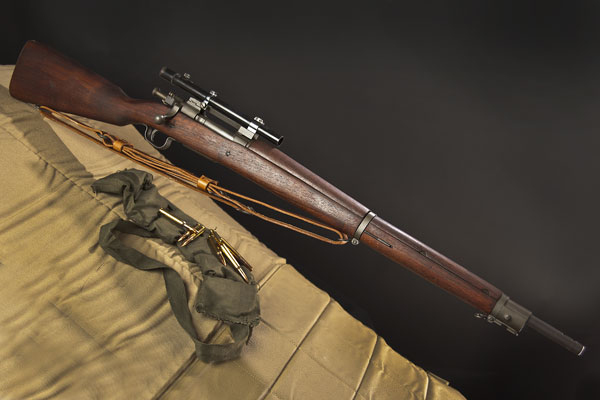
As far as warhorses are concerned, few have been ridden longer than the Springfield 1903. The tried-and-true five-round bolt-action made its appearance soon after the Spanish-American War and served all the way up to Vietnam. Heck, the U.S. Army’s Drill Team still snaps to attention with this classic at their side. The rifle came about due to U.S. troops being outclassed by the Spanish Army’s M1893 Mauser in the Spanish-American War. Utilizing design points from the Springfield Model 1892–99 Krag–Jørgensen (which the Springfield replaced) and the Mauser G98, the 1903 was born. The two biggest improvements on it from the ’Krag–Jørgensen were a faster-to-load internal magazine, one able to utilize stripper-clips, and a chamber able to handle higher-pressure rounds. It was originally chambered to shoot the short-lived .30-03, but was soon upgraded to fire the legendary .30-06 Springfield.
Learn More About The Springfield M1903
1911 Pistol

A true red-blooded American semi-auto. In the 20th Century, there has been no more revered firearm than the M1911. Created by prolific firearms designer John M. Browning, the semi-automatic pistol, or some variation on it, has seen action in nearly every American conflict since World War I. And like the Springfield Rifle, the pistol was born out of the harsh lessons of war. In the Philippine-American War, Moro guerrilla just wouldn’t drop after multiple shots of .38 Long Colt from soldiers’ Colt M1892 revolvers. Long story short, this sparked trials to replace the revolver that lasted nearly 6 years. In the end, Colt’s M1911 was the last gun standing. What made it a desirable sidearm is what still attracts shooters today — its simplicity and reliability. A look back at the field tests themselves sums it up pretty well, “[D]uring a 6,000 round test fired over two days in 1910… (Browning’s) sample pistol became so hot that it was simply dunked in a pail of water to cool it for further firing. Browning’s sample reportedly passed the test with no malfunctions.” The other aspect of the M1911 that makes it so desirable, it’s chambering. The .45 ACP delivers a lot of energy on the target, but not at the cost of being unmanageable.
Learn More About The Colt 1911
Browning M2
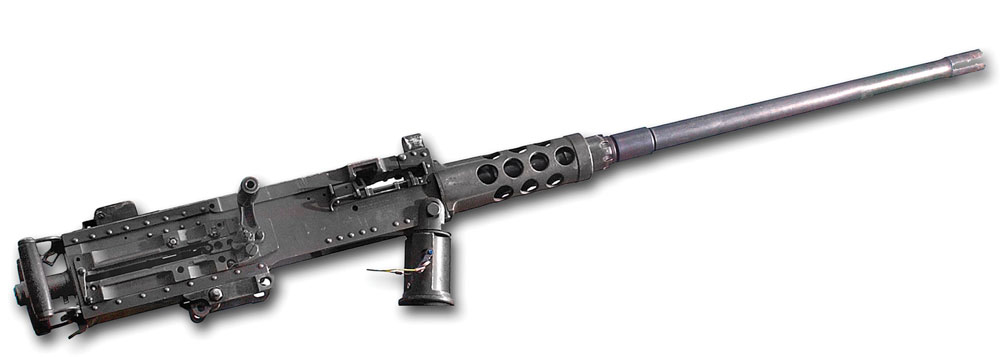
Ma is American fury in .50 caliber. Next to the M1911, the M2 Browning is the longest serving firearm in the U.S. inventory. And unless there is some major breakthrough in the near future, expect this wicked behemoth to continue slinging whoop ass down range for years to come. As its name suggests, it is yet another brainchild of firearms genius John M. Browning and came about due to the increased use of armor in World War I. Pitching the mammoth .50 BMG (Browning Machine Gun) round, the M2 could make mincemeat out of all but the heaviest armored vehicles and a whole bunch more. In fact, Ma Deuce’s versatility is most likely what keeps her forever young. The massive .50 caliber has and is used for nearly every conceivable military purpose, from anti-personal to hard-target interdiction to anti-aircraft to primary and secondary weapons on fighting vehicles. And it has an incredible range of projectiles to send at enemies, giving a heavy machine gunner an astonishing toolbox from which to work.
Learn More About The Browning M2
M1 Garand
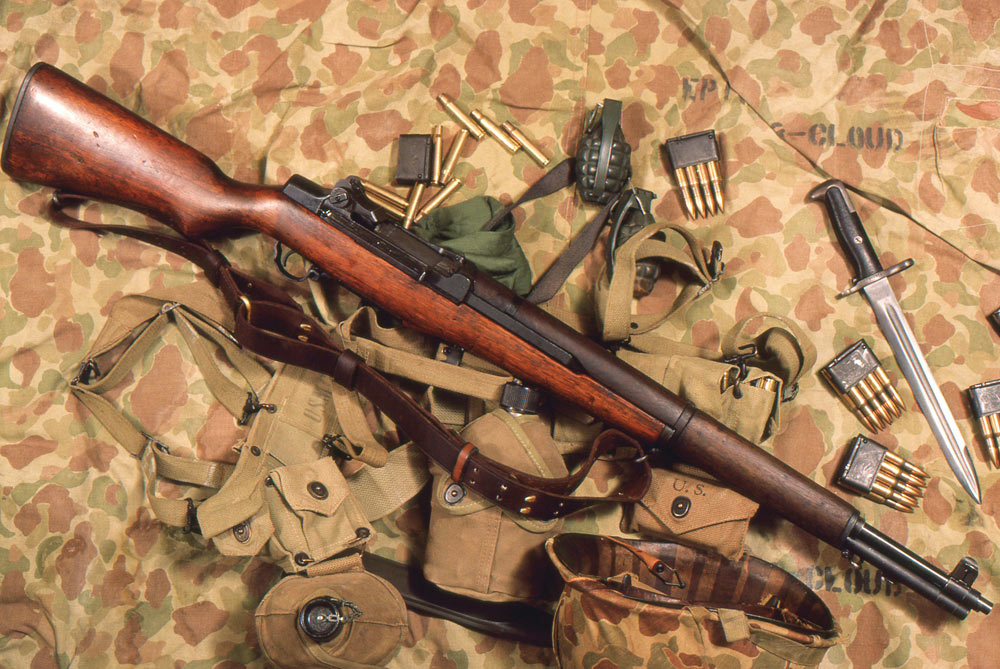
Of all the arrows in the U.S. Military’s quiver during World War II, the M1 Garand was the sharpest. While the rest of the world’s military forces were playing around with bolt-action rifles during the conflict, the Yanks were laying down accurate, high-volume fire with the M1. In short, the Garand was decisive. No wonder Gen. George S. Patton dubbed it “the greatest battle implement ever devised.” The .30-caliber M1 Garand was adopted by the U.S. in 1936, replacing the 1903 Springfield. John Garand, who was as unique as his weapon, devised the rugged and reliable rifle. The French-Canadian immigrant caught the attention of the government, who gave him a position at the Springfield Armory. The machinist turned engineer spent the next decade and a half basically devising the M1. Luckily, it was just in time to lead our boys to victory in the countryside of Europe and the islands of the Pacific.
Learn More About The M1 Garand
AR-15
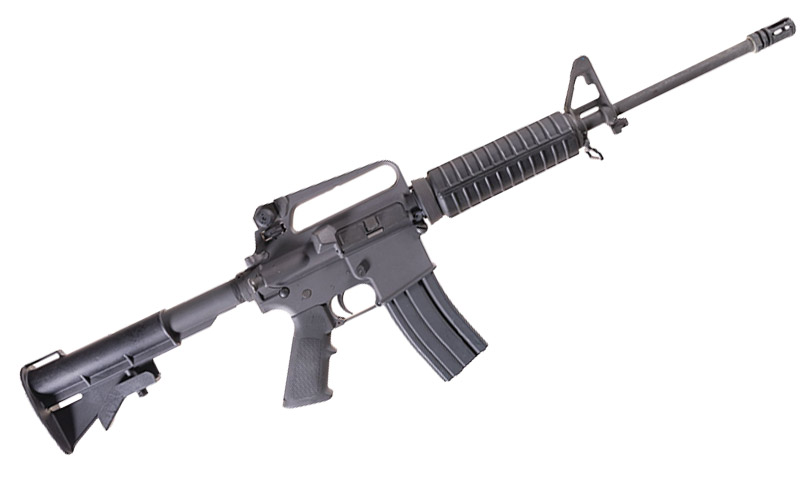
This is the undisputed modern day American rifle. If for no other reason than how dang widespread the AR-15 and all its variants have become both on the civilian and military markets. And with manufacturers playing with new chamberings and design points all the time, only expect the Black Rifle to grow in scope and scale. As far as American gun designs are concerned, at least circa the 1950s, the AR-15 was a radical departure. Plastic, aluminum, small caliber — it seemed to run counter to all intuition, especially for a rifle that would (or more precisely its military adaptation, the M16 would) eventually take the place of the wood and steel M14. Perhaps the most revolutionary point of Eugene Stoner’s design was the use of direct gas impingement (though he did not consider it exactly this) to cycle the AR-15. While the concept existed, it was not the dominant design point at the time, with most of the world’s semi-automatic rifles utilizing short- and long-stroke piston systems. Opting for DI, Stoner not only engineered a lighter rifle, but a more accurate one, due to the fact that the AR-15’s barrel was essentially free floating. The other aspect that has kept the rifle rolling is its capacity. The AR-15’s eventual chambering of the small-bore, high-velocity 5.56 NATO/.223 Rem., not only allowed more rounds per magazine but also more ammunition to be carried on person.
Find Your Next AR-15
Remington Model 870

It makes sense there is only one shotgun on this list, because there are few other smoothbores that are even half as prolific as the Remington Model 870. The only one that gets close is the Mossberg 500, which has surpassed the 10 million mark. As of 2016, more than 11 million of the rough-and-ready Remington pump-actions had been produced. That puts it up there as one of the most manufactured firearms in history — a list primarily dominated by military rifles. The reliable 870 has played nearly every role expected of a shotgun, from hunter to home-defense weapon to law enforcement tool to battle implement. To the first point in that list, 870s could very well have put more meat on the table than any other gun given its sheer profusion. What made the 870 (and still makes it) such a hit when it was introduced in 1950 was its affordability and performance. Utilizing new post-World War II manufacturing techniques, Remington was able to churn out these dependable, well-made smoothbores en mass and economically. The first year alone there were 15 different models to choose from. And given their sturdy construction, they’re pretty danged hard to stop from chewing through shells. Good chance rats and cockroaches will use the 870 to fight each other long after man disappears from the face of the earth — at least the American ones.
Find Your Next Remington 870
M1 Carbine
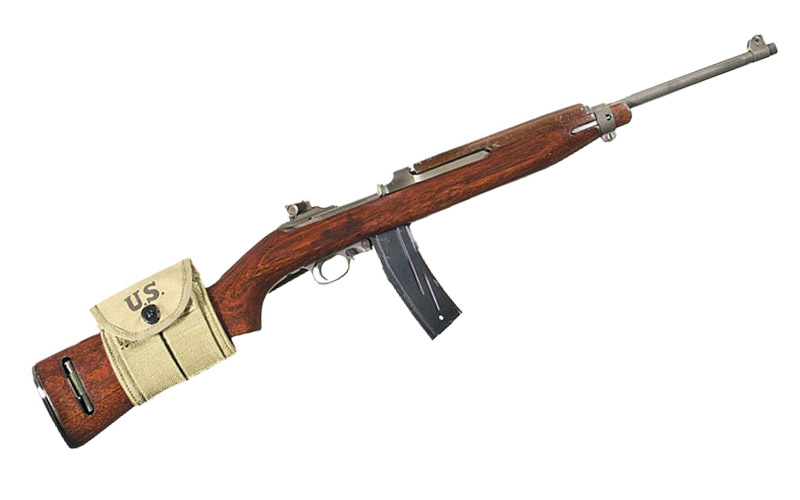
While today there is no shortage of lightweight, intermediate-caliber carbines, that was not always the case. The AR-15 was only beginning to be adopted by U.S. armed forces in 1962, and it took quite a while longer for it to become the ultra-common working man’s rifle that it is today. For many decades following WWII, that role was filled by the M1 carbine. Officially designated as the United States Carbine, Caliber .30, M1, the M1 carbine is very lightweight and handy, even having a folding stock variant. It’s chambered for .30 Carbine, a 110-grain projectile that travels about 1,990 fps. This allowed it to serve as a pseudo-intermediate cartridge before that concept was truly introduced with 8mm Kurz. Issued with 15- and 30-round detachable box magazines, the M1 (and eventually M2) carbine served as one of our nation’s most formidable small arms for many years both at home and abroad. Much like what would happen later with the AR family of rifles, servicemen who had experienced the M1 carbine at war understood its utility, leading many to acquire their own after returning home. For many years before the proliferation of AR-15s, the M1 was the most “tacticool” option available. The M1 carbine may have never received the household-name recognition that the General Patton-endorsed M1 Garand did, but it is equally as historically important and was arguably an even more forward-thinking design when it was introduced.
Editor's Note: Adam Borisenko contributed to this article.

Next Step: Get your FREE Printable Target Pack
Enhance your shooting precision with our 62 MOA Targets, perfect for rifles and handguns. Crafted in collaboration with Storm Tactical for accuracy and versatility.
Subscribe to the Gun Digest email newsletter and get your downloadable target pack sent straight to your inbox. Stay updated with the latest firearms info in the industry.

![Best Concealed Carry Guns In 2025 [Field Tested] Wilson Combat EDC X9S 1](https://gundigest.com/wp-content/uploads/Wilson-Combat-EDC-X9S-1-324x160.jpg)


![Best 9mm Carbine: Affordable PCCs [Tested] Ruger Carbine Shooting](https://gundigest.com/wp-content/uploads/Ruger-Carbine-Shooting-100x70.jpg)
![Best AR-15: Top Options Available Today [Field Tested] Harrington and Richardson PSA XM177E2 feature](https://gundigest.com/wp-content/uploads/Harrington-and-Richardson-PSA-XM177E2-feature-100x70.jpg)

I have had seven(on the list if you allow a “Italian 1873”) and still have four. My lever of choice is the 336 but do own an original 92SRC in 38-40. That is surely an iconic American Rifle, even if it is residing up here in North western Ontario.
Hard to argue with the list from a strictly military view. However, I would substitute a few in and a few out from a strictly sporting standpoint. Whichever view you have, an enjoyable article.
I had five of the ten. My list of course has a lever action rifle; but I chose the Winchester ‘94, which has probably been used to harvest more deer over the last 125 years than any other rifle. The Thompson M1928 (all variants). What is more American than the “Tommy Gun”? Perhaps the Smith & Wesson Model 29 .44 Magnum. Just about everyone World-wide knows Dirty Harry and his big, bad forty-four. Another great American revolver is the Colt Python. It’s instantly recognizable vent-rib, full underlug barrel has been copied by many, but the original is still the best. I agree with the previous poster that the Ruger 10/22 deserves consideration.
I have five of the ten and can tell you they all are iconic guns. The other five I could not afford.
Good list, really hard to argue with any of the selections. There are a couple of other types you could easily have included – the Thompson, obviously. The “Tommy Gun”. The Remington Rolling Block would also be a possibility, as well as the ubiquitous S&W line of DA revolvers. Say, the original .357 Magnum Registered model? Lastly, and you’ll probably laugh, the Ruger 10/22. Is there any other rimfire that so clearly defines the words “plink” or “fun gun”?